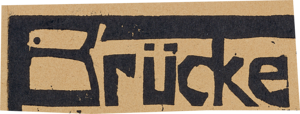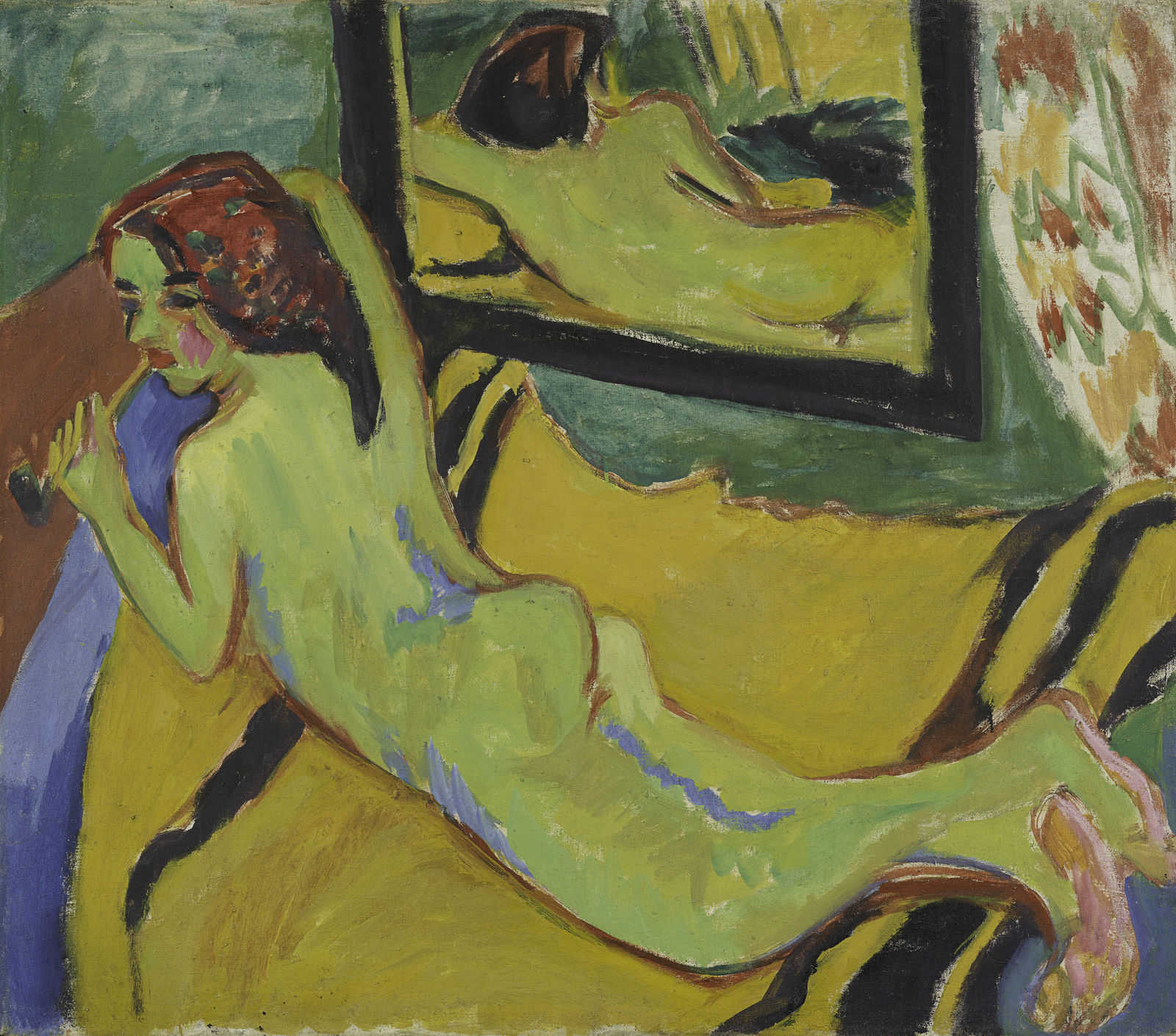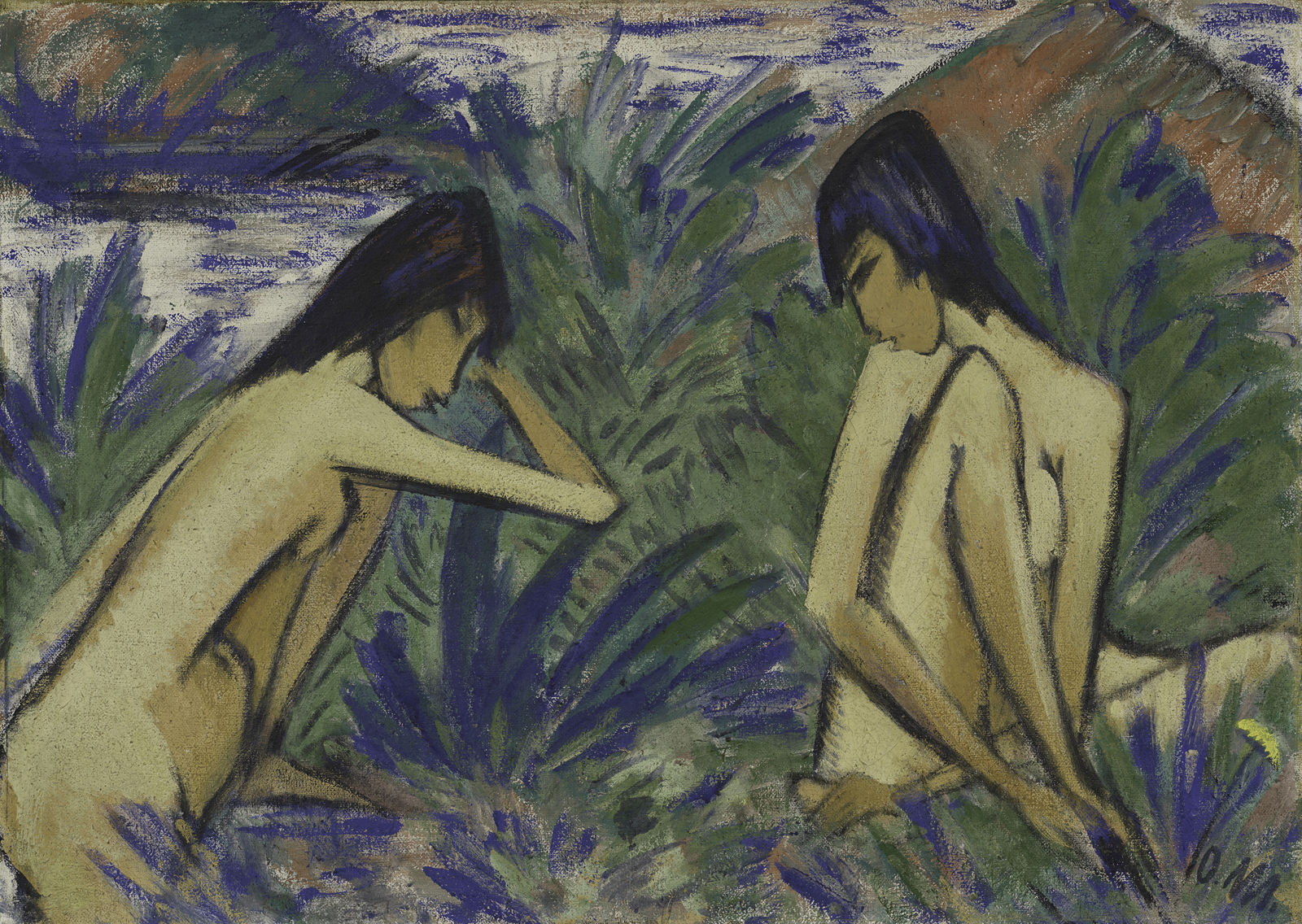In the works by Brücke artists, we find countless depictions of human figures, many of which are nudes. If we look at the naked human body from today’s perspective, issues of the body and gender emerge.
As part of a workshop, six participants discussed Ernst Ludwig Kirchner’s work Liegender Akt vor Spiegel. They spoke of bodies from their individual perspectives. Participants included Auro Orso, Claude Förster, Felicia, Icecold Alma, Josephine A.V. Deutesfeld, and Sandra Ortmann | Panda.
Auro:
For me, the first thing that struck me is that it is a very – how do you say – standardised body, that is, a body that definitely conforms to the beauty ideals of our current, Western society very, very well – because it is very slim. And what I also noticed is the perspective, from above looking down. And that there is a strong focus on the buttocks and they are even shown twice – in the mirror and from above – but it does seem a bit like they are being looked at in the context of a power relationship. At the same time, the person seems very relaxed and they are smoking something, my first thought was perhaps opium, I don’t know exactly which time period it is from.
Auro:
What I find glaring is this red hair, because it is also such a blatant symbol of sexuality. On the other hand, it also used to be associated with witches, and for me red – or rather the red umbrella – is the colour of sex work.
Felicia:
But what immediately caught my eye is that you have a 360-degree view of this person because of the mirror. It’s a bit disconcerting because I don’t find the position very relaxing either. My first impression was that it’s about portraying this figure from all angles, and not so much about this person in particular. That the mirror has been used to try and capture every possible angle.
Josephine:
When I looked at the picture, it just caused a lot of confusion for me, I couldn’t really pair the reflection with the actual person that well. I wondered whether it was an abled or disabled body, because the forms confused me, and I find that the form I see in the first body is not reflected in the second.
Auro:
Maybe I’m reading too much into it, but it has a blatant feeling of a male gaze, this idea that maybe the person is someone who does some form of sex work. I don’t know, there is also a bit of this obsession, mordable in Spanish, that is this curiosity and the thrill of the forbidden that many people have with sex workers. On the one hand there is this feminine, mysterious beauty, where everything is so beautiful and flowing. On the other hand, that the person is sad or addicted to opium. And that is such a cliché, it can be seen in many pictures and films, and people get off on it a bit.
Icecold:
Now that you mention it, I recently saw this Hannah Gadsby comedy show where she talks about male artists painting “flesh vases for their dick flowers” all the time. Somehow that was the first thing that came to my mind: this body lying like this, squashed into this couch – yes, crushed into this couch.
Josephine:
In the rear image the person is lying in such a relaxed way, they could lie there for a really long time, and I don’t find that in the front image. I feel as if I have two pictures in front of me: one is the person in front and the other is the person in the mirror. The whole time I am wondering whether there could be two subtexts in there, because they belong together, but they are also like two sides – one in the flesh and one in the reflection – and it could also simply be intentional that the reflection is done a little differently. I wonder how they belong together, because there is a disconnect for me, but I do wonder what the connection is between the two.
Claude:
What I’m still wondering is whether you tend to look down at the person in front and look up at the other person, or is that just because of the way I have my screen?
Panda:
I understand the male gaze thing, but at the same time I think there’s also a respectful way of looking down, which can have a lot to do with consent and agreement. And how tall is the person painting and how low is the bed? For me, it becomes a bit funny again if there is someone standing on a little stool to peer down from above.
Icecold:
Is that supposed to be the edge of the bed that’s above her? And this red and blue stripe is not visible in the mirror at all – you could say it’s a coincidence due to the perspective – but because of that, the colours in the room in the mirror are just green and blue, and this blue, which disappears completely, is otherwise only found on her skin and that’s only in the other room. I also get the impression that garish colours are not so respectable, but that’s just my interpretation, and maybe that also leads to this smoothness we were talking about, where there are only yellow and green tones and in the other one there is this red and blue, which could lead to the confusion.
Icecold:
For example, when I think about my work and lying on my stomach like this, I think that it’s a position I don’t like to be in, I like to be able to see people and if I have this mirror, then I want to at least see them through the mirror, so I know, okay, I’ve got you covered. It seems like a super vulnerable position to me, one in which I immediately feel tense. I think that triggers this interpretation in me, this facial expression where I think, okay, that doesn’t look relaxed to me, despite the pipe, it looks more like a work setting.
Felicia:
In my life I have already been in a situation where there was a naked depiction of my body, but it was for medical purposes and also in a blatantly medical setting, with a trans background. Those are the situations that I have in the back of my mind. Especially when I see the picture and realise that this person, if they wanted to, would have nowhere to retreat to, because the mirror is there and it makes it impossible to pull the blanket up in front, but at the same time the person is lying on the blanket and there is nothing around them. And maybe that’s part of it, that the person doesn’t want to do that right now, but that creates a bit of anxiety.
Auro:
I had an experience once where I directed a performance, a play. I have been working a lot with anals lately and with the tension between the fact that the ass is something sexualised and gendered, that the asshole, so to speak, is something that is blatantly taboo. And for this I was working with two cis women my age, they stood on the stage and I was the person who told them what to do. The responsibility felt really stark. I feel like as soon as there’s nudity involved – and with nudity in art there’s just so much weight there, it’s too much responsibility for one person. When you’re busy taking pictures or painting, there should be another person who is just there to make sure that the person in the picture is okay.
Auro Orso (he/They) is a Berlin-based performer and dancer who explores topics such as genderfuck and decolonisation in his work
Claude Förster (Claude/they) is a tattoo artist and illustrator from Hamburg who is interested in art – both looking at it and making it. www.unterstrich.ink
Felicia (sie), 27, is a queer activist and democracy mediator
Icecold Alma (they/them), is a stripper and sex worker with a migration background who likes to read novels, preferably by the sea
Josephine Ansah Valerie Deutesfeld (sie/ihr) is a philosopher who loves creative aesthetics on a large and small scale and enjoys writing and reading
Sandra Ortmann | Panda (sie/they), is a qualified psychologist who works as a curator for education and outreach at Schwules Museum. She advises museums and cultural institutions on issues of diversity-oriented organisational development, discrimination and outreach









